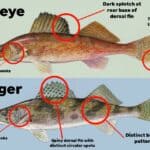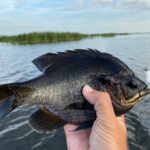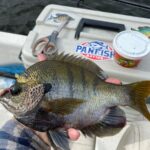Florida is well known as a premier fishing destination for a wide range of fish species…
But did you know that Florida is one of the best states in the country for catching specks (black crappie)?
I am born and raised in Florida and have been fishing for specks my entire life. In this article, I’m going to tell you everything you need to know about speck fishing in Florida.
I’ll cover tips, tricks, tactics, tackle recommendations, when to go and where to go.
By the end of this article…you’ll be ready to catch a cooler full of slabs!
This page contains affiliate links. As an Amazon Associate, I earn from qualifying purchases.
Table of Contents
How Do You Fish For Specks In Florida?
To catch specks (black crappie) in Florida, you need to understand where specks move throughout the year. Most anglers have trouble finding specks, not getting them to bite. Once you locate fish, catching them is easy with the correct baits and tactics.
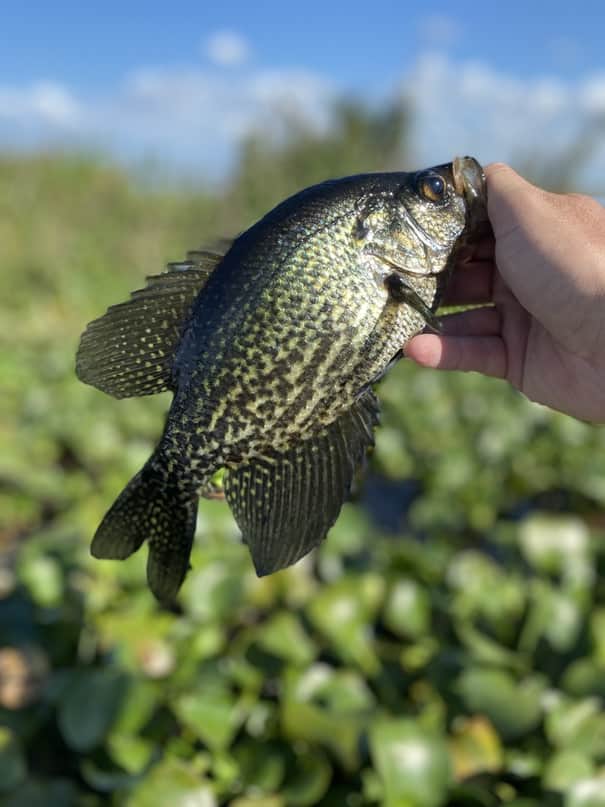
By understanding what kind of habitat, water temperature, and forage (food) specks prefer, you’ll be well on your way to finding them and being successful.
There are a number of ways to fish for specks in Florida, and although there is no right or wrong way…there is a preferred method based on the time of year and lake you are fishing.
Trolling
Trolling for specks is a common method that works really well in Florida when specks are scattered along shorelines, weed lines, and natural edges.
Trolling is usually don’t behind a boat with an electric motor, but it can also be done behind a kayak or canoe by slowly paddling.
Trolling for specks should be done at a slow speed, usually around 1-1.5 mph. More importantly, is that you troll slow enough to get your bait or lure down into the strike zone. That may be only a few feet, or it may be as deep as 12+ feet.
This method works well in the summertime using jigs when specks have moved off from shallow spawning areas and are scattered in deeper water.
Spider-Rigging
Spider-rigging for specks is a method you’ll often see professional crappie fishermen employ. With this tactic, you outfit your boat with 8-16 rods in all different directions (which makes your boat look like spider legs).
Each rod can use different bait, a different depth, even different colored lures. So essentially you are testing to see what the crappie are biting, and where they are located.
This method can be very effective! (in fact, some states limit the number of rods and reels you can actually use).
But, it takes a lot of fishing gear, special rod mounts, and a pretty good system to get it dialed in.
Fishing Heavy Cover
Fishing in heavy cover is synonymous with ‘Florida style‘ fishing. Basically what I mean is fishing in the weeds!
Specks love to hide in cover, and during the winter and spring spawning season they lay their eggs in shallow water often under and around submerged vegetation.
Lilly pads, cattail reeds, hydrilla, hyacinths, eelgrass, cypress, willow, stumps..that is all prime cover for specks!
If you’ve never done it before…it may seem a bit odd. But punching through heavy cover and getting your bait or lure down can be very effective.
It’s like Florida ice fishing!
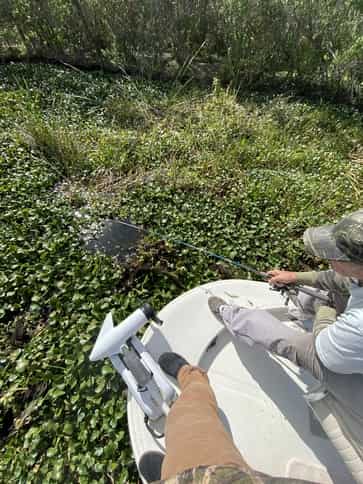
Free-casting
Free casting for specks is what the name implies…simply casting around your bait and lures trying to locate fish.
Docks, weeds, bridges, stump fields, pits, and canals are all prime locations for free-casting for specks.
If I only have a few hours to fish…ill simply troll around and cast my favorite speck lure. You can do it from a boat, kayak, canoe, or crappie fishing from the bank.
It may not be as technical as some of the other ways to catch specks…but everyone starts out by free casting and it’s an excellent way to learn a lake and find fish.
Florida Speck Fishing Tips
Below are my tips for speck fishing in Florida…these are the same tips and tactics used by guides and professionals…so shhh, don’t tell them I told you!
Downsize your jigs
Yes, that’s right…smaller is better. Stop using 1/4 oz jig-heads and big hooks! Use the smallest size jig or hook that you can effectively fish.
Move with the sun
As the sun gets brighter and more overhead…specks will go deeper and hide under cover. When it’s cloudy and in low light conditions, specks will be closer to the surface, and away from cover.
Punch holes in thick cover
In Florida many speck fishermen use a potato rake or similar tool to literally punch a hole in the vegetation, creating a clear section to drop down their bait.
Here is a picture of my homemade rake I use to create small pockets to fish:
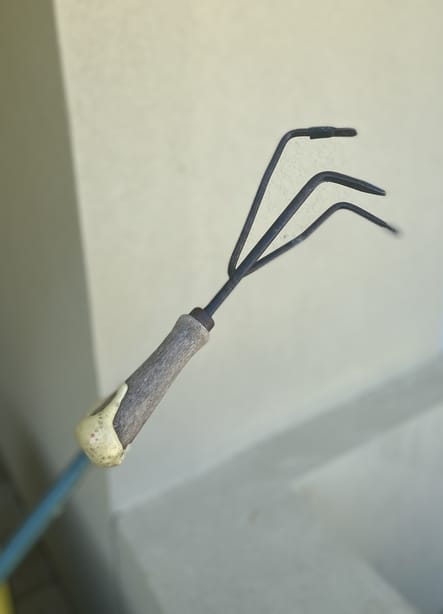
Find the shad
Keep a close eye out for threadfin shad…they are a favorite forage for black crappie. Find the shad, and I bet crappie will be nearby.
Stop over-twitching your rod
This one drives me crazy! There is no reason to drop down a jig and bounce your rod tip up and down like it’s a carnival game. Simply drop your jig down, and let the current, wind and water do the work. A twitch every now and then is okay…but sometimes less is more.
Try Livescope
This revolutionary technology is changing the way people fish…and for better or worse, it’s extremely effective at locating schools of specks (but getting them to bite is another story).
You May Also Like: Garmin Livescope, Is It Really Worth The Money?
Speck Fishing Seasons
The best time of year to catch specks in Florida is during the winter spawning months of December to March. During this time of year specks move into shallow water, 1-4 feet deep when the water temperature reaches 68 degrees Fahrenheit.
Each lake, river or pond will have some variation as to when specks move shallow. In south Florida, it may be as early as November.
In north Florida, specks may move into shallow water as late as February. That is why it’s important to test out different areas, talk to fellow anglers and monitor the water temperature.
Specks can be caught year-round in Florida, but the spawning season is the most lucrative and the best time of year to catch crappie.
I also like catching specks during the summer, when they are staged along edges and drop-offs…perfect for trolling!
Where To Find Specks In Florida
There are a few ways to find out if there are specks in your area.
1.) Talk and network with other anglers. Call around to your local FWC office, bait and tackle shop or stop into the boat marina. Ask around for places to speck fish. Most anglers are willing to help!
2.) Search around for places to fish in your area…there are a ton of ways to get creative and find fishing spots with today’s technology.
Finding Speck Habitat
Once you find a lake, pond, or river you want to try fishing, do some research on the lake itself. Get your hands on a map of the lake, or look on google earth.
Ask yourself: what stands out? What is unique about this lake? Does it have any rivers or creeks flowing in and out? Does it have any deep channels, pits, or canals?
Does the shoreline look heavily vegetated, or does it have a lot of stumps?
These are all questions you can answer by doing some research. That research will help you formulate a plan of attack.
My recommendation is to choose 2-4 starting areas of the lake and give them a try. Maybe first try shallow, right along the water’s edge. Next, try near docks, bridges, and other structures. And after that, maybe try trolling in deeper water.
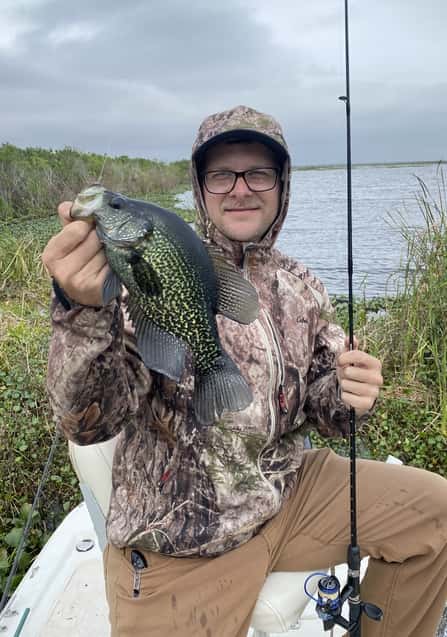
As you experiment with different locations, fishing tactics, and baits you will begin to develop patterns.
Sometimes, ruling out where fish are not located, is just as important as actually finding the fish.
Specks do not like a bright sun. They have large eyes and thrive in deeper and darker environments. When in doubt, look in the weeds, under shaded structures, or go deep!
Keep an eye out for schools of shad and surface feeding activity. Ledges, deep holes, and submerged trees can all hold speck during the summer months.
During the spawning season, stay shallow. You’re wasting your time if you are in water over 8 feet deep.
Specks do not lay eggs in a nest-like a bass or bluegill, instead, they deposit eggs on substrate and vegetation- like cattails and hydrilla!
Best Baits For Speck Fishing
For natural and live baits, the best baits for specks are:
- Live minnows
- Grass shrimp
- Threadfin Shad
- Small shiners
- Crickets
I prefer live minnows if I am going to use natural bait because they are inexpensive, easy to catch, easy to keep alive…and they catch fish!
But, don’t overlook grass shrimp!
In Florida, grass shrimp live in hydrilla, weeds, and roots all along the water’s edge. This is a prime food source for specks, especially when fishing shallow water during the spawn!
Lures For Speck Fishing
The most popular artificial lures for catching specks are small jigs. These simple and effective lures come in dozens of shapes, sizes, and varieties that have a subtle action, perfect for triggering bites from specks.
They are also very easy to fish, you can skip them under docks with an ultralight rod, or jig them in the lilypads on the end of a cane pole.
I personally use the Crappie Magnet jig heads and jigs and they are phenomenal! They are very durable, perfect size and they’ll catch bass too!
Fro traditional lures, or ‘hardbody‘ baits, anything that imitates a minnow or other baitfish will catch specks in Florida. Some of the most popular lures for specks are:
If you prefer to fly fish, and really want to step your game up, check out my article on the 6 best flies for crappie fishing.
Catching specks on a fly rod is so much fun!
Speck Fishing Rigs
I grew up catching specks on a bamboo cane pole with 6 lb Stren monofilament. I am not a fishing reel or rod snob by any means!
And nowadays, there are so many good rod and spinning reel manufacturers out there all making good quality equipment.
I am partial to the Piscifun family of rods and reels because they are very affordable for the working class anglers (like me) and they offer some amazing deals and specials almost every month.
Other popular brands that specialize in speck fishing rigs are B’n’M, ACC Crappie Stix, and Lews Slab Shaker Combo.
Best Speck Lakes In Florida
Florida is home to literally thousands of lakes, and many of them are filled with hungry specks!
Some of the most popular lakes in the state for specks are:
- Lake Talquin
- Lake Monroe
- Lake Kissimmee
- Lake Okeechobee
- Crescent Lake
- Lake Toho
- Lake Marian
- Lake George
- Orange Lake
- Rodman Reservoir
Each and every one of those lakes have a long history of producing big specks, and large quantities of fish…
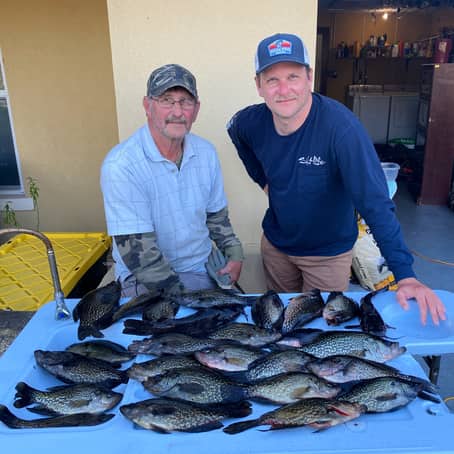
But what about the not-so-famous lakes?
Well, you’re in luck. Below is a list of what I think are ‘sleeper lakes’ for speck fishing in Florida. These lakes often get overlooked, or don’t get the attention they deserve when it comes to specks:
- Stick Marsh/Farm 13
- Headwaters Lake/Fellsmere Lake
- Lake Miccosukkee
- Lake Hall
- Starke Lake
- Alligator Lake
- Lake Conway
- Deer Point Lake
Frequently Asked Questions
Why are crappie called specks in Florida?
‘Speck‘, is a term derived from ‘Speckled Perch‘ which is another name for Black Crappie. In Florida, locals refer to the popular fish as specks.
Where is the best speck fishing in Florida?
Many lakes in Florida could lay claim to the best speck fishing in the state, however, Lake Okeechobee is the largest and most consistent producer of specks.
When do speck spawn in Florida?
The speck spawning season starts as early as November and can last until March. Spawning is triggered when water temperatures reach 68 degrees.
Are speckled perch and crappie the same?
Speckled Perch and crappie are the same fish.
What is another name for speckled perch?
Other nicknames for speckled perch include specks, sac-a-lait (usually used for white crappie), papermouths, slabs, calico bass, oswego bass and black perch.
Final Thoughts
Speck fishing in Florida is one of my all-time favorite activities.
The fish are as beautiful as the scenery and in some places, they are completely unpressured which makes for phenomenal fishing.
Taking the time to learn how to catch specks is very rewarding…and let’s not forget there are tons of great panfish recipes out there so you can enjoy your bounty.
I hope the tips in this article encourage you to go out and catch a cooler full of slabs! Thanks for reading.
You May Also Like: The 7 Best Crappie Lakes In Georgia (Full Review!)
If you haven’t guessed yet, I love fishing and everything about it!
To learn more about why I started Panfish Nation, visit the About page and follow along on Social Media:


Download a copy of my FREE Lure Color Selection Chart & Knot Guide!
Stay up to date with fishing reports, tackle reviews, industry news, and much more! We respect your privacy, unsubscribe at any time.
Like this post? Save it on Pinterest.
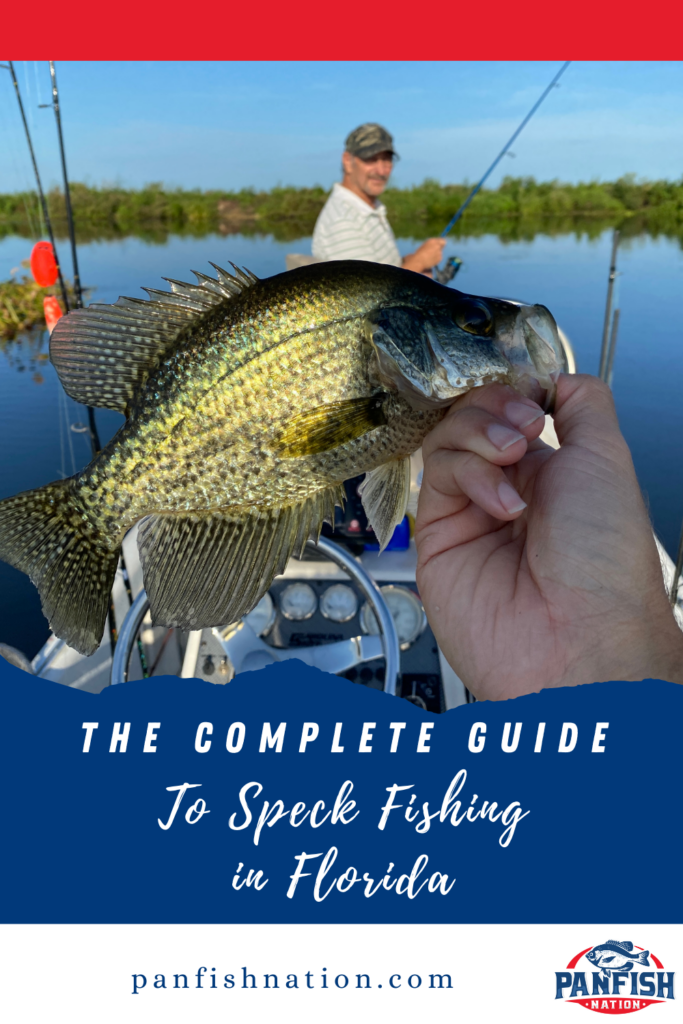
Additional Posts
- Sauger vs Walleye: Learn These Differences and Catch More!
- Crazy Facts About the World Record Crappie
- What Size Hooks for Smallmouth Bass? Quick Guide
- Large and in Charge-Mouth: 10 of the Best Bass Lures of All Time (And Where to Buy Them)
- Emperor of the Sun(fish): What You Need to Know About the World Record Bluegill
- Coppernose Bluegills: How They’re Different from Common Bluegill

